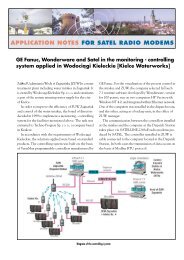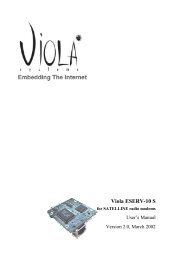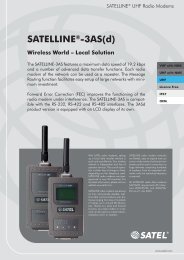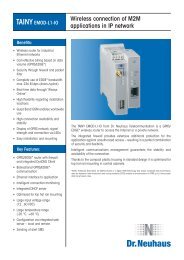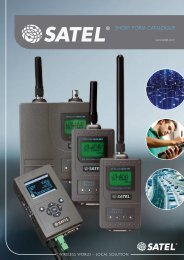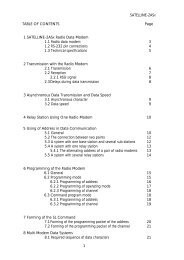SATELLINE® -3AS(d) - Satel Norge
SATELLINE® -3AS(d) - Satel Norge
SATELLINE® -3AS(d) - Satel Norge
Create successful ePaper yourself
Turn your PDF publications into a flip-book with our unique Google optimized e-Paper software.
P L A N N I N G A N E T W O R K<br />
PLAN NETWORK REQUIREMENTS<br />
Like other engineering tasks, design<br />
of a radio modem network requires<br />
a set of rules to be followed for producing<br />
the desired result. Both the<br />
radio connections themselves and<br />
the compatibility of the surrounding<br />
system need to be considered.<br />
The first part of the design is to<br />
evaluate the requirements the system<br />
environment, geography, and the<br />
local radio frequency and transmission<br />
laws.<br />
SYSTEM ENVIRONMENT<br />
• Data protocol<br />
• Interface types<br />
• Maximum response times<br />
GEOGRAPHY<br />
• Station locations<br />
• Topographic profiles<br />
• Buildings or other obstacles<br />
LOCAL RADIO TRANSMISSION<br />
REGULATIONS (AUTHORITIES)<br />
• Available radio channels<br />
• Max. Radiated power<br />
• Tx/Rx duty cycle<br />
PLAN NETWORK HARDWARE<br />
With the desired system performance<br />
and the limitations above in<br />
mind, the first version of the radio<br />
modem network can be designed:<br />
1. Radio modem types and serial<br />
cable wirings are specified.<br />
2. Radio links are simulated giving<br />
the antenna types and heights,<br />
feed cable lengths, and whether<br />
any additional repeater stations<br />
will be needed.<br />
3. If necessary, other system components<br />
like RF filters, RF relays,<br />
combiners, lightning protectors,<br />
power supplies, and installation<br />
parts are specified.<br />
4. Data transmission delays are calculated<br />
for the sufficient number<br />
of RF channels.<br />
After these four steps, the system<br />
design is typically detailed enough<br />
for a commercial quotation.<br />
TEST THE COMPONENTS BEFORE<br />
FINAL INSTALLATION<br />
Data communication tests at the factory,<br />
radio signal propagation, and<br />
radio interference tests on the field<br />
are important. The tests verify the<br />
functionality of the designed system,<br />
compatibility to the surrounding<br />
system, and the correct settings of<br />
the devices. Proper signal-to-interference<br />
margin is essential for reliable<br />
error-free radio communications.<br />
REPEAT TESTS AFTER<br />
FINAL INSTALLATION<br />
By repeating the communication<br />
tests after the final installations, the<br />
system designer may verify that the<br />
radio network design works with the<br />
desired application.<br />
27



